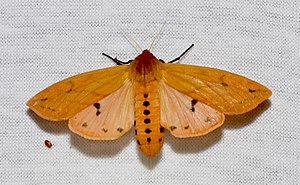Pyrrharctia isabella
| Pyrrharctia isabella | ||||||||||||
|---|---|---|---|---|---|---|---|---|---|---|---|---|

Pyrrharctia isabella , female |
||||||||||||
| Systematics | ||||||||||||
|
||||||||||||
| Scientific name | ||||||||||||
| Pyrrharctia isabella | ||||||||||||
| ( Smith , 1797) |
Pyrrharctia isabella is a butterfly ( moth ) from the subfamily of the bear moth (Arctiinae).
features
butterfly
The moths have a wingspan of 45 to 65 millimeters, with the females being larger than the males. The upper sides of the wings have an orange-yellow to yellow-brown basic color, from which a few small black dots stand out. The upper side of the hind wing in the females is pale yellowish pink. The yellowish to reddish hairy thorax is characterized in both sexes by black spots along the middle and on the sides.
Caterpillar
The caterpillars are densely hairy all over the body. In the front and back, the hair is black, in the middle red-brown to rust-red. In English usage, the species is therefore usually referred to as the Banded Woolly Bear ( Banded Woolly Bear ).
Distribution and occurrence
The species is distributed in North America to arctic regions, more numerous in the north and east. It prefers to inhabit open, dry to slightly damp habitats.
Way of life
In the northern regions the moths fly in June and July and in autumn in two generations a year. Several generations are sometimes formed in the south. The male moths visit artificial light sources . The females emit an aerosol made up of many droplets of sex pheromones . The relatively large amount of the sex pheromone can be explained by the short period of time a female has to find a reproductive partner due to the short arctic spring. The caterpillars feed on the leaves of various plants, including asters , ( aster ), birch , ( betula ), maple ( acer ), clover ( trifolium ), and sunflower ( Helianthus ) species . The overwintering caterpillars create a cryoprotectant in their circulatory fluid ( hemolymph ) in order to survive extremely cold winters.
Trivia
In the eastern United States and Canada , folklore is widespread that the extent of the reddish brown and black hairs on the caterpillar in autumn provides a prediction of the intensity of the coming winter. It is assumed that if the red-brown stripe is wide, the winter will be mild and if the red-brown stripe is narrow, the winter will be very cold. There is no scientific justification for this theory. However, it is used as an opportunity in many small towns to hold a Woollybear Festival as a tourist attraction , for example in Vermilion in Ohio .
swell
Individual evidence
- ^ Butterflies and Moths of North America
- ↑ caterpillar on youtube
- ↑ dissemination
- ↑ Nature Journal
- ↑ The Old Farmer`s Almanac
- ↑ Woollybear Festival
Web links
- silkmoths - The Isabella Tiger Moth
- bugguide.net - taxonomy
- woolly-bear-caterpillar - caterpillar photos

